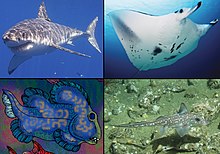
Back Kraakbeenvisse Afrikaans Knorpelfische ALS أسماك غضروفية Arabic اسماك غضروفيه ARZ Chondrichthyes AST Qığırdaqlı balıqlar Azerbaijani قیغیرداقلی بالیقلار AZB Кимерсәкле балыҡтар Bashkir Храстковыя рыбы Byelorussian Храстковыя рыбы BE-X-OLD
| Cartilaginous fishes | |
|---|---|

| |
| Example of cartilaginous fishes: Elasmobranchii at the top of the image and Holocephali at the bottom of the image. | |
| Scientific classification | |
| Domain: | Eukaryota |
| Kingdom: | Animalia |
| Phylum: | Chordata |
| Subphylum: | Vertebrata |
| Infraphylum: | Gnathostomata |
| Clade: | Eugnathostomata |
| Class: | Chondrichthyes Huxley, 1880 |
| Living subclasses and orders | |
| |
Chondrichthyes (/kɒnˈdrɪkθiiːz/; from Ancient Greek χόνδρος (khóndros) 'cartilage' and ἰχθύς (ikhthús) 'fish') is a class of jawed fish that contains the cartilaginous fish or chondrichthyans, which all have skeletons primarily composed of cartilage. They can be contrasted with the Osteichthyes or bony fish, which have skeletons primarily composed of bone tissue. Chondrichthyes are aquatic vertebrates with paired fins, paired nares, placoid scales, conus arteriosus in the heart, and a lack of opercula and swim bladders. Within the infraphylum Gnathostomata, cartilaginous fishes are distinct from all other jawed vertebrates.
The class is divided into two subclasses: Elasmobranchii (sharks, rays, skates and sawfish) and Holocephali (chimaeras, sometimes called ghost sharks, which are sometimes separated into their own class). Extant chondrichthyans range in size from the 10 cm (3.9 in) finless sleeper ray to the over 10 m (33 ft) whale shark.
- ^ "Mazon Monday #19: Species Spotlight: Bandringa rayi #MazonCreek #fossils #MazonMonday #shark". Earth Science Club of Northern Illinois - ESCONI. Retrieved 4 October 2020.
- ^ "Bear Gulch - Delphyodontos dacriformes". Fossil Fishes of Bear Gulch. Archived from the original on 25 February 2015. Retrieved 15 May 2019.
- ^ Mutter, R.J.; Neuman, A.G. "An enigmatic chondrichthyan with Paleozoic affinities from the Lower Triassic of western Canada". Acta Palaeontologica Polonica. 51 (2): 271–282.
- ^ "Fossilworks: Acanthorhachis". fossilworks.org. Retrieved 17 December 2021.
- ^ Long, John; Thomson, Victoria; Burrow, Carole; Turner, Susan (28 October 2021), Pradel, Alan; Denton, John S.S.; Janvier, Philippe (eds.), "Fossil chondrichthyan remains from the Middle Devonian Kevington Creek Formation, South Blue Range, Victoria" (PDF), Ancient Fishes and their Living Relatives, Munich, Germany: Verlag, Dr Friedrich Pfeil, pp. 239–245, ISBN 978-3-89937-269-4, retrieved 30 November 2023
- ^ Charlie J. Underwood and Jan Schlogl (2012). "Deep water chondrichthyans from the Early Miocene of the Vienna Basin (Central Paratethys, Slovakia)". Acta Palaeontologica Polonica. 58 (3): 487–509. doi:10.4202/app.2011.0101.
- ^ Anderson, M. Eric; Long, John A.; Gess, Robert W.; Hiller, Norton (1999). "An unusual new fossil shark (Pisces: Chondrichthyes) from the Late Devonian of South Africa". Records of the Western Australian Museum. 57: 151–156.
- ^ Adnet, S.; Hosseinzadeh, R.; Antunes, M. T.; Balbino, A. C.; Kozlov, V. A.; Cappetta, H. (1 October 2009). "Review of the enigmatic Eocene shark genus Xiphodolamia (Chondrichthyes, Lamniformes) and description of a new species recovered from Angola, Iran and Jordan". Journal of African Earth Sciences. 55 (3): 197–204. Bibcode:2009JAfES..55..197A. doi:10.1016/j.jafrearsci.2009.04.005. ISSN 1464-343X.